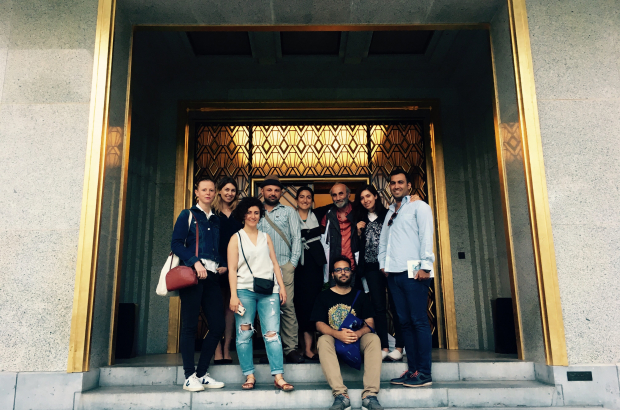- Daily & Weekly newsletters
- Buy & download The Bulletin
- Comment on our articles
Arts institute is a one-stop shop for culture in Flanders
Last year, the Flanders Arts Institute welcomed 360 curators and industry professionals from around the world. Almost all of them were given a custom-made programme, allowing them to visit local studios and meet artists whose work interested them.
These invitations proved to be an effective way to boost the international careers of local artists. The mission of the institute, which was founded in January 2015, is broader, however.
“Our activities are concentrated around three axes,” explains general director Felix De Clerck. “We are a local arts information centre, we have a research and development department, which is constantly monitoring the field, and we act as a kind of dating agency, bringing together people and ideas to support careers in the arts.”
That’s exactly what happened this year when the institute invited Mami Kataoka, chief curator at the Mori Art Museum in Tokyo and, more importantly, the artistic director of the forthcoming Biennale of Sydney. The event’s entire programme, which takes place from March to June next year, hasn’t been announced yet, but De Clerck says her final selection “will include four or five artists we brought to her attention”.
The Flanders Arts Institute, based in the centre of Brussels, is the result of the merger of three expertise and support centres: the Flemish Theatre Institute (VTi), the Flemish Institute for Visual, Audiovisual and Media Art (Bam) and Flanders Music Centre (Muziekcentrum).
More visibility
VTi and Bam, which oversaw performing and visual arts, had a strong focus on research and had already spoken of their intention to collaborate more intensively, according to Dirk De Wit and Delphine Hesters, the organisation’s head of visual arts and head of performing arts, respectively.
Feelings were more mixed, however, at Flanders Music Centre, which already had a strong international network. “Not everyone in the music sector was convinced a merger would be beneficial,” explains Wouter Degraeve, head of music at the Flanders Arts Institute. “The distance from the sector has grown a bit, but on the other hand, now we can do research, too, and there are obviously more opportunities for interdisciplinary collaborations.”
Degraeve, who moved from Flanders Music Centre to the Arts Institute, is currently preparing the release of a survey into the presence of non-classical Flemish music on international stages.
De Clerck, meanwhile, points out that important issues such as sustainability, diversity and the socioeconomic position of the artist aren’t limited to specific disciplines. “Speaking with one voice is also beneficial for our external relations,” he says. “Both local and foreign parties benefit from our one-stop shop to reach the arts in Flanders. It makes us more visible, as a guide and as a facilitator, in an already very competitive field.”
He sees the constant interaction between his research capacity and the practical knowledge of his experts as a unique force. “Typically our organisation will conduct a major survey first,” he says. “Later, we implement the results in different disciplines.”
Survey says…
For instance, a survey of Flanders’ cultural centres showed that these art hubs did virtually nothing with visual arts. “To increase local know-how, we organised workshops about creating an exhibition: preparing an estimate, going on studio visits, visual art design and so on.”
Bearing in mind the €2 million annual budget (for a population of 6.5 million people), De Clerck is convinced Flanders is punching way above its weight on an international level. “We are still surfing on the wave of an arts scene that’s profiting from an enormous amount of individual talent and a bottom-up cultural policy that was able to capture this at the right moment,” he says.
The Flanders Arts Institute is now developing a method to measure the international appeal of their artists. “So, in the near future we will be able to pinpoint more profoundly what really made the difference,” explains De Clerck. “Was it the recruitment of a professional management, the presence at an influential showcase event…?”
Of course, one has to be aware of the reality behind the numbers, adds Hesters. “In the performance arts, international stage opportunities for our actors and dancers are the same as they were 15 years ago, but we also hear that the work needed to reach these numbers has equally increased.”
In recent times, with less government money going to the arts, new international collaborations have become more focused on sharing knowledge. “For instance, a lively interaction with art scenes in North Africa, the Middle East, Eastern Europe and the Balkans is now starting to happen,” says De Wit, who supervises the institute’s international relations department.
There have been successful open calls for exploratory artist visits to Beirut, and there was a Flemish presence at a contemporary dance festival in Marrakesh as well as a music festival in Rabat.
“More than ever, we have to join forces and diversify our means,” says De Clerck. “There may be less money for culture as we know it, but at the same time Europe and the Flemish department of foreign affairs value the community-forming and diplomatic power of the arts.”
Photo: A delegation of arts professionals from Iran and Armenia visit the Villa Empain in Brussels, courtesy of Flanders Arts Institute









